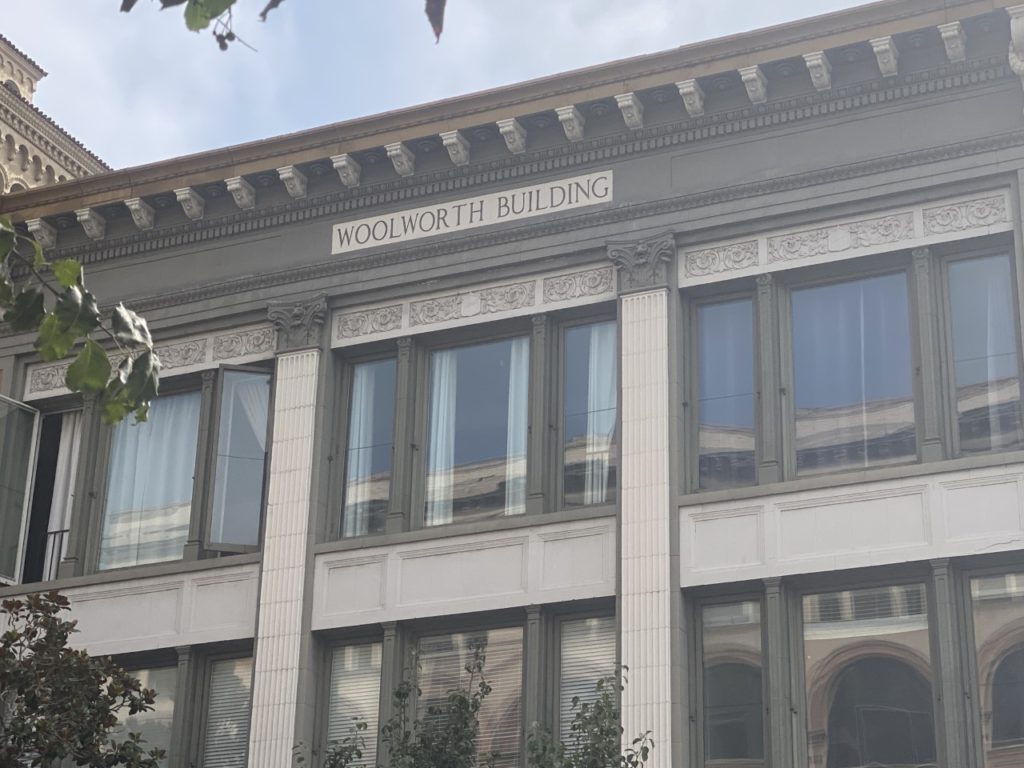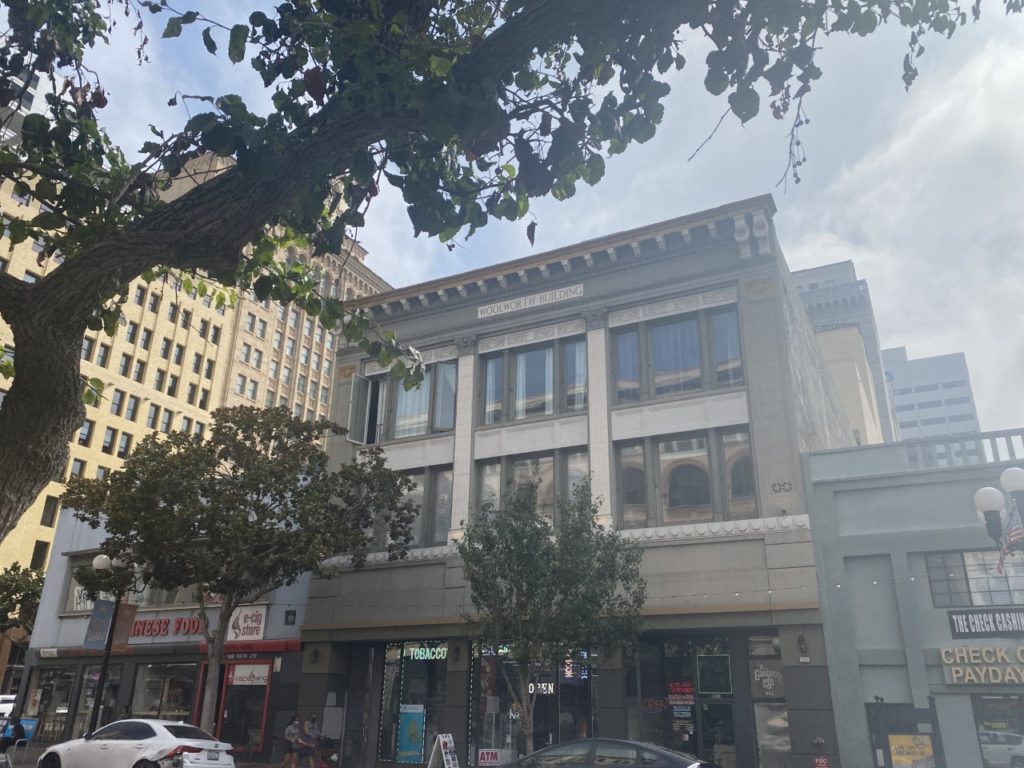No products in the cart.
Landmarks
A Million Gilded Treasures……
The Woolworth Building
(1922)
945 Fifth Avenue
Architectural Style: Roman Neo-Classic
Architect: Cass Gilbert of New York City
Building Contractors: Allan Macdonald & Felix Kahn
Gone are the days when one could get something of value for five or ten cents, but many of us remember roaming up and down the brightly lighted aisles of Woolworth’s searching for the perfect trinket or gift to take home. When our shopping was done, we could satisfy our sweet tooth with an ice cream from the stainless-steel Woolworth’s lunch counter. Those days are gone, but the lovely gothic building with its F.W. Woolworth signage remains – just waiting for the right merchant to bring it back to its days of splendor.
Before the current building was erected, the site was the home of the Gilbert block. Alonzo Horton transferred title of the lot to Alfred H. Gilbert in 1871. Mr. Gilbert had come to San Diego in 1868 and established the first lumber company in the county. He would personally sail up the coast to Humboldt Bay to select the choicest lumber cuts for San Diego’s homes and businesses. Unfortunately, Mr. Gilbert passed away in 1879 at the age of 46 from pneumonia. His sole heir was his wife, Augusta. In 1886, she constructed what was to be called the “Gilbert block.”
The Gilbert block was a three-story brick building with a wood frame, and a central staircase with a large skylight over the stairs. The slate roof incorporated a fire wall, which rose 18 inches above the roof. There were eleven windows on the second and third floors with a wood awning in front and a brick chimney also towards the front of the structure. Probably the most notable feature of the Gilbert block was the set of bay windows flanking the entrance.
The first floor was divided into retail stores, while the second floor was used for offices, and the third floor housed furnished rooms.
The offices housed doctors, dentists, and the Howard and Lyons real estate company. The first floor was home to a variety of businesses including a grocery store, a military, a dry goods store, and several clothing retailers.
In 1922, the building was destroyed beyond repair by fire. However, Frank Winfield Woolworth, the principal founder of the F.W. Woolworth Company of New York City, had leased the land from Augusta Gilbert for fifty years at $10,000 per year several years prior to the fire. Woolworth, a stock boy, had gotten his start when he suggested to his employers, dry goods merchants, Moore and Smith of Watertown, New York, that they put slow moving and surplus merchandise on the top of the counter and sell it for five cents. Remarkably, the goods moved quickly, and the store then started displaying new merchandise out on the counters. Five more stores grew out of this countertop experiment. Woolworth then borrowed $300 from William Moore and opened his own five-and-dime store. Through a series of clever expansions and mergers, by 1912, Woolworth had purchased and consolidated 581 stores throughout the country and formed the F. W. Woolworth Company. He died in 1919, and at his passing, the company had reached annual sales revenue of 100 million dollars per year.
Upon Frank Woolworth’s death, his brother, Charles Sumner Woolworth, took over the company as Chairman of the Board, and remained in that position until he retired in 1944.
In 1922, the Woolworth Company then contracted with Allan Macdonald and Felix Kahn of Los Angeles to build a new store on the Gilbert site for $125,000. It is widely believed that the architect was Cass Gilbert of New York, the Woolworth corporate architect, as both the San Diego store and the flagship store in New York, embody many identical elements and are designed in the same style. The New York store, opened in 1913, was the tallest building in the world until 1930. Both buildings were clad in part with terra cotta, had granite bases, featured Corinthian columns, and utilized large amounts of decorative gold leaf inside.
The San Diego store was a three story with a basement, fireproof reinforced, concrete edifice with a Roman neo-classical terra cotta and grey granite facade. It featured four Corinthian style pilasters and a composition roof with decorative brackets. The ground floor had two recessed entrances on Fifth Avenue with large plate glass windows on either side The most notable feature of the interior was a profusion of massive electrical lighting fixtures. – the latest from 5th Avenue in New York. The store space spanned over 10,000 square feet lined with modern glass display cases, mirrored, and gilded posts and additional handsome wood counters. A beautiful winding staircase led shoppers to the second floor. Many shoppers said that the store was better lighted in the evening than during the day!
The second and third floor exteriors featured three sets of tripartite windows, each divided by decorative pilasters topped with rose medallions. Each set featured a large rectangular central window flanked by a pair of smaller rectangular windows. The third-floor windows had a narrow frieze across the top of each window section, and the bottom of the roof support brackets feature a narrow band of dentil molding.

This spectacular edifice was opened on January 19, 1923, to much fanfare and the strains of a full orchestra! San Diego was enchanted!
For many years the company did a strictly five-and-dime business, but eventually incorporated stainless steel lunch counters and soda fountains. Those very same lunch counters became focal points for “sit-ins” during the turbulent civil rights movements of the 50s and 60s.
Woolworth’s continued to expand, and ultimately had stores in Canada, London, and throughout the Caribbean and South and Central America. On a personal note, as a child I looked forward to the twice-yearly trips my grandmother and I would make to Havana from our home in Oriente province, so I could shop for dollhouse furniture in Havana’s huge Woolworth’s. The attendant would hand me a shopping basket, and I would fill it to overflowing with miniature furniture and rubber babies. Even though I could barely see over the counters, I wasn’t too shy to ask for assistance in reaching all those treasures. Aisles and aisles of treasures! Cuba eventually boasted having eight Woolworth’s, but none could compare with Havana’s.
With expansion came diversification, and in 1963, Woolworth’s acquired the Kinney Shoe Corporation, which eventually created the Foot Locker stores that Woolworth’s would become. The growth and expansion, plus the rise of suburban shopping malls, ultimately contributed to its fall. By 1997, Woolworth’s closed all its remaining stores in the US.
The San Diego store was seismically retrofitted in 2001, and steel beams, elevators and more staircases were added. It re-opened as street- level retail and live/work lofts on the second and third floors.
A little brevity was added, circa 2015, when a comedy club opened for a short while.
The building is now for sale.
Sandee is the historian and lead tour guide for the Gaslamp Quarter Historical Foundation. She can be reached at [email protected].

